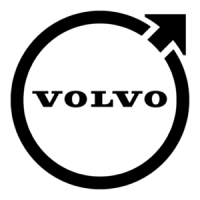
Do you have a question about the Volvo G720B and is the answer not in the manual?
| Brand | Volvo |
|---|---|
| Model | G720B |
| Category | Construction Equipment |
| Language | English |
Symbol and text indicating potential hazards and operator responsibility for safety.
Overview of AWD panel, controls, and warning lamps.
Control lever for scarifier/ripper/windrow eliminator and articulation lever for turning.
Operator duties, precautions, and hand signals for safe operation.
General rules and pre-operation checks for safe machine use.
Procedures for starting the machine, including checks of gauges and controls.
Step-by-step procedures for starting the engine, including cold start and preheating.
All Wheel Drive system operation, applications, and deactivation conditions.
Basic steering operation, front wheel lean, and steering using articulation.
Service brakes operation, failure warnings, and stopping the machine.
Operation of the differential lock/unlock switch for traction and turning.
General guidelines and safety precautions for towing the grader.
Procedures for loading, unloading, and securing the grader for transport.
Procedure for maneuvering the moldboard into a left-hand side high bank sloping position.
Operation, shank depth, tooth angle, and tooth replacement for the scarifier attachment.
Operation, tooth angle, shank removal, and tooth changing for the ripper attachment.
Moldboard positioning, pitch, angle, toe, and heel for effective grading.
Operation of scarifier and ripper for breaking up hard surfaces.
Procedures for placing the grader in the service position before maintenance.
Additional service position steps, awareness of personnel, and hydraulic system safety.
Safety procedures for welding and working with electronic components, and battery safety.
Fire extinguisher use, cleanliness, and actions to take at the first sign of fire.
Safety precautions for working with high-pressure hydraulic systems and components.
Safety precautions for working with electrical systems and batteries, including explosive gases.
Safety precautions for refueling, preventing static electricity, and fire hazards.
Checking hydraulic oil fluid level based on operating ranges and ambient temperatures.
Safety precautions for tire repair, replacement, and inflation, including safety cages.
Daily checks of engine oil level and hot oil precautions.
Fuel tank maintenance, cleaning, and fuel filter replacement procedures.
Checking air cleaner hoses and connections, and primary filter replacement.
Coolant level checks, antifreeze concentration, and corrosion protection.
Step-by-step procedure for starting with jumper cables and charging batteries.
Transmission oil pressure monitoring and checking transmission oil level.
Inspection of AWD hoses and fittings, and changing AWD gearbox oil.
Schedule of required maintenance measures based on hour meter readings.
Service brake system description and parking brake specifications.
